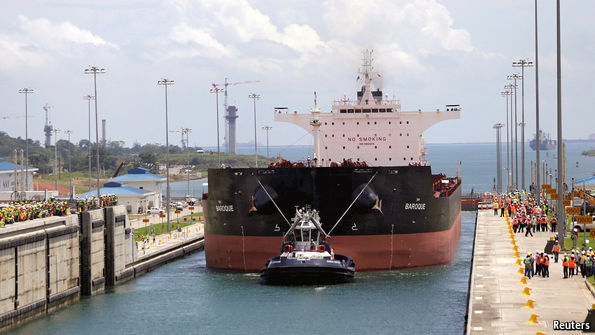The Panama Canal
Wider impact
What the expansion of Panama’s waterway means for world trade

WORKERS at a fish market in Panama City disagree on the benefits of the country’s newly widened canal. One optimistically hopes the government will have more funds to pay for air-conditioning in their broiling workplace. Another draws a finger across his throat and says, “The people will get nothing.” A third calls it “the biggest opportunity” in Panama. The last verdict is certainly true of the government’s take. The revenue it receives each year from the Panama Canal Authority (ACP) is expected to double to around $2 billion in 2021. This is a country that knows how to reap the benefits of its geography.
The ACP will be able to charge more for passage to bigger ships now that massive new locks have been built at both the Pacific and Atlantic ends of the canal and channels have been deepened and widened. The $5 billion venture will be inaugurated on June 26th when the first vessel officially sails through. The widening of the canal was initially mooted before the second world war, but became more urgent as ever larger ships were unable to use it.
Over 960m cubic metres of cargo passed through the canal in 2015, a new record and an amount that Francisco Miguez of the ACP calls “the maximum we could do in the existing locks”. The expansion increases capacity to 1.7 billion cubic metres. The biggest container ships that could use the old canal, known as Panamaxes, can carry around 5,000 TEUs (20-foot equivalent units, or a standard shipping container). Neo-Panamaxes that will squeeze through the new locks can carry around 13,000 TEUs. Although the world’s largest ships have space for nearly 20,000 TEUs, the majority of the global fleet will now fit through the canal.
East-coast ports are preparing for the windfall, says Mika Vehvilainen of Cargotec, a maker of cargo-handling equipment. Ports in Baltimore, Charleston, Miami, New York and Savannah are updating facilities to accommodate the Neo-Panamaxes. The Port Authority of New York and New Jersey plans to spend $2.7 billion on enlarging its terminals and shipping lanes, and a further $1.3 billion to raise a bridge by 20 metres.
Shipping lines’ costs will also fall, in part through economies of scale but also because ports are automating facilities at the same time as preparing them for Neo-Panamaxes, says Kim Fejfer, boss of APM Terminals, the ports division of Denmark’s Maersk Group, the world’s biggest shipping firm. Ports in the Gulf of Mexico are already embracing these new technologies.
Customers may not, however, benefit much from the reduction in shipping costs. Rates have already fallen over the past two years—by up to 40% for containers on some routes, and slightly less for bulk commodities such as coal. The response, industry consolidation, may mute incentives to pass savings on. Earlier this year China’s two biggest shipping lines merged to form the world’s fourth-largest operator. Firms are also building alliances to manage capacity. In January 2015 Maersk and MSC, the world’s largest shippers, launched 2M, an alliance to share space on their vessels. In May this year, six other shipping lines with a global market share of 18% launched “The Alliance”. There are rumours of a huge tie-up between several medium-sized firms.
Widening the Panama Canal may not bring cool air to sweaty fishmongers. But it should certainly give some parts of the shipping industry a boost. Whether the benefits of lower costs trickle down to consumers will depend on the internal machinations of the shipping industry.


No comments:
Post a Comment